Meet Steve, your new favorite astronomical phenomenon

Say hello to Steve.
Steve isn't a person. Steve is actually the unofficial name of a mysterious purple streak of light observed by some social media savvy skywatchers keeping an eye out for the northern lights.
SEE ALSO: I am so unreasonably jealous of this view of the southern lights
The Alberta Aurora Chasers — a Facebook group devoted to the northern lights — caught sight of Steve in photos taken of the curtains of the auroras (and decided to name him).
The one issue is that no one was quite sure what Steve was. That is, until a high-powered spacecraft got involved.
One of the three European Space Agency's Swarm satellites actually flew through a Steve phenomenon, according to Eric Donovan of the University of Calgary.

Image: NASA
Donovan matched up images taken of Steve from the ground with observations taken by the satellite and found something surprising.
“As the satellite flew straight though Steve, data from the electric field instrument showed very clear changes," Donovan said in a statement.
It looks like Steve is actually a flow of hot gas moving much more quickly than the air around it, and while there's still a lot more to learn about the astronomical phenomenon, this is a good start.
And Steve's not all that rare.
“It turns out that Steve is actually remarkably common, but we hadn’t noticed it before," Donovan said.
"It’s thanks to ground-based observations, satellites, today’s explosion of access to data and an army of citizen scientists joining forces to document it."
The fact is that Steve couldn't have been discovered in earlier decades.
“In 1997 we had just one all-sky imager in North America to observe the aurora borealis from the ground,” Donovan said.
“Back then we would be lucky if we got one photograph a night of the aurora taken from the ground that coincides with an observation from a satellite. Now we have many more all-sky imagers and satellite missions like Swarm so we get more than 100 a night.”
Thanks to these observations we know that auroras are created when charged particles from the sun bombard Earth's upper atmosphere, interacting with neutral particles and making them glow.
This creates the beautiful green and red curtains of the northern and southern lights. And also, we guess, Steve.
